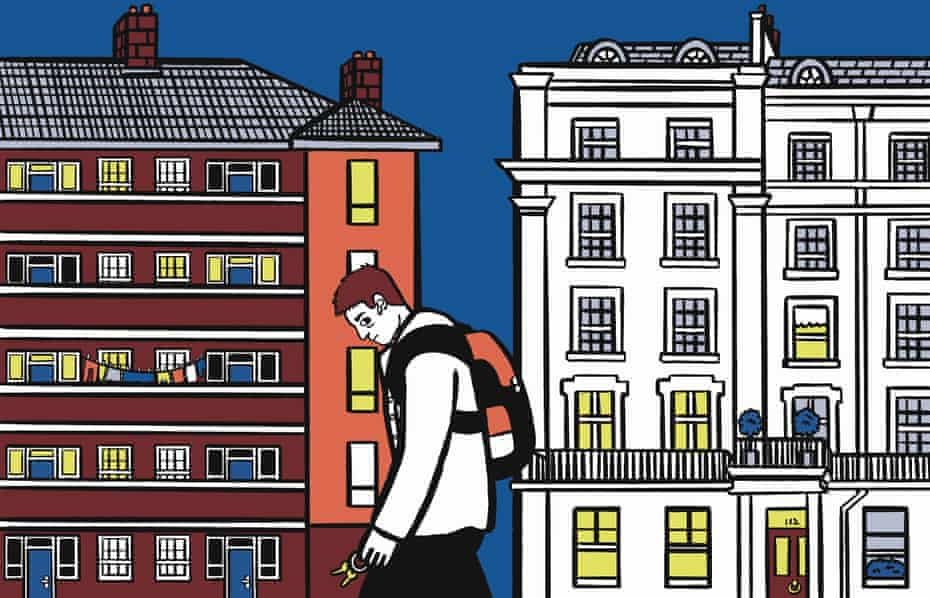Owen Jones in The Guardian
The young are hungry and the rich are on the menu. This delicacy first appeared in the 18th century, when the philosopher Jean-Jacques Rousseau supposedly declared: “When the people shall have no more to eat, they will eat the rich!” But today this phrase is all over Twitter and other social media. On TikTok, viral videos feature fresh-faced youngsters menacingly raising their forks at anyone with cars that have start buttons or fridges that have water and ice dispensers.
So should the world’s billionaires – and fridge-owners – start sleeping with one eye open? Hardly. It’s clear that millennials (those born between the early 80s and the mid-90s) and zoomers (the following generation) are not really advocating violence. But it is also clear that this is more than just another viral meme.
The world’s most famous leftwing millennial, New York’s rebellious Democrat Alexandria Ocasio-Cortez, neatly sums up the generation’s zeitgeist. If leftism often seems to be the preserve of socially awkward nerds – hi! – and shouty older white men, she is the totem of the cool kids who like their redistribution of wealth and power with a hefty side order of mainstream popular culture.
It doesn’t sit easily with some: when the congresswoman accepted a free invitation to the uber-exclusive Met Ball in a dress emblazoned with “Tax the rich”, even some leftists joined the right in puffed-up outrage. Whether you thought it was an audacious demand for the sickeningly rich to cough up at their own exclusive party – or a stunt compromised by taking place in a real-life version of The Hunger Games’s Capitol – it showed that elites can’t escape the young flexing their political muscles.
According to a report published in July by the rightwing thinktank the Institute for Economic Affairs (IEA), younger Britons have taken a decidedly leftwing turn. Nearly 80% blame capitalism for the housing crisis, while 75% believe the climate emergency is “specifically a capitalist problem” and 72% back sweeping nationalisation. All in all, 67% want to live under a socialist economic system.
With a seemingly hegemonic Tory party on a high after routing Corbynism, the IEA warned that the polling is a “wake-up call” for supporters of market capitalism. “The rejection of capitalism may be an abstract aspiration,” it says. “But so too was Brexit.” It’s a striking phenomenon on the other side of the Atlantic, too: a Harvard University study in 2016 found that more than 50% of young people in the heartland of laissez-faire economics reject capitalism, while a 2018 Gallup poll found that 45% of young Americans saw capitalism favourably, down from 68% in 2010.
Jack Foster, a 33-year-old bank worker from Salford, shows how lived experience has fed this disillusionment with capitalism. After he dropped out of university and worked in a call centre – a “horrible job” – the financial crash shaped his political attitudes, as they did for much of his generation. But housing loomed particularly large. “I was renting, thinking: ‘How will I ever be able to afford a house?’” he says. “My mum was a cleaner, my dad was disabled, and the people I knew who could afford a house got help off their parents. It wasn’t a case of having a job and saving up; you had to inherit money.”
Dating apps are another, less formal way of seeing where the wind blows. The apps have increasingly become no-go zones for Tory supporters. Given Labour had a 43-point lead among the under-25s in the last election – unlike in 1983, when the Tories had a nine-point lead among our youngest voters – the dating pools of the youthful true blue have shrunk. “No Tories – it’s a deal breaker”, “Absolutely no Tories (the left are sexier anyway, facts)”, “Swipe right if you vote left” and “Just looking for someone to hold hands with at the revolution” adorn profiles on Tinder, Hinge and Bumble.
Many of the young have concluded that an economic strategy that penalises them, coupled with a “culture war” that denigrates many of their deeply held values, amounts to a Tory declaration of war on their generation. Anyone who buys into that is, therefore, deemed profoundly unsexy.
For the IEA’s Kristian Niemietz, this is partly down to a “reputational change” for socialism. Once associated with “fringe groups”, he thinks it is now more “a fashion statement, definitely on social media, where people construct a socialist persona which they use for image purposes”. Where he agrees with the left is that an epic housing crisis should receive much of the blame for its renewed attractiveness.
“Whether you ask free marketeers, conservatives, centrists, the centre-left or socialists, all believe the UK has a housing crisis, that it’s a massive problem, but all have different answers about where it comes from and what to do about it,” he says. “If people are getting ripped off and think the market is rigged against them, the one way people can react to that is to generalise: ‘This is what capitalism is like – what the market is like’, making them more sympathetic to socialist ideas.”
 Rather than a ‘property-owning democracy’, Britain looks more like a landlord’s paradise. Illustration: Jacky Sheridan/The Guardian
Rather than a ‘property-owning democracy’, Britain looks more like a landlord’s paradise. Illustration: Jacky Sheridan/The Guardian
In the 80s, Margaret Thatcher’s ideological mentor Keith Joseph described the push for homeownership as resuming “the forward march of embourgeoisement which went so far in Victorian times”. The great hope, for many Thatcherites, was that the “right to buy” would transform Labour-voting council tenants into Tory-supporting homeowners, a view later echoed by either David Cameron or George Osborne, one of whom Nick Clegg recalled objecting to building more social housing on the grounds that “it just creates Labour voters”.
But rather than the “property-owning democracy” promised by Thatcherism, Britain looks more like a landlords’ paradise. By 2017, 40% of the homes flogged off under right to buy were owned by private landlords charging twice the rent of council properties. Indeed, in the space of two decades, the odds of a young adult on a middle income owning a home more than halved. These young people have been called generation rent, with about half of the under-35s in England renting in a private sector often defined by extortionate rents and insecurity.
Rents in England take up approaching half of a tenants’ take-home pay, and an astonishing 74.8% in London, up one-third since the century began. And if millennials bet the house, so to speak, on a parental lifeboat, disappointment beckons: the typical inheritance age is between 55 and 64, and the median amount handed down is about £11,000, meaning half receive less.
There is no rational reason, of course, for the young to defend this economic system. According to a 2019 poll by the charity Barnardo’s, two-thirds of under-25s believe their generation will be worse off than their parents. Keir Milburn, an academic and the author of Generation Left – which argues widespread leftist sympathies among the young are a modern phenomenon bred by economic conditions – says this pessimism is new. “For someone born in the 60s who came into adulthood, there was a sense of optimism, that things will be better,” he says. “It’s the Enlightenment, modernist attitude that things will get better, society will always generally progress. Now it’s just [the author] Steven Pinker who thinks this.”
David Horner, 30, a charity worker in London, began feeling disenchanted with the prevailing system when he was at university. Now he has a child on the way, he worries about the world he’s bringing them into. From working with younger people from poorer communities to listening to the experiences of friends working in crisis-ridden health and education services, he’s in no doubt about the problem. “But we’re told this is the apex, the best we can get as a political economic system, and any alternative – even if it’s seemingly not that radical – just gets pushed away, that this is the way things have to be,” he says. “As I’ve got older, there’s that unfortunate feeling that you don’t want to accept the way things are, but there’s so much power, and corporations and people with vested interests in capitalism and the way the economy works at the moment.”
A generation was told that it was important to go to university to have a salary you could live on. But the earnings gap between graduates and non-graduates has fallen substantially and, despite England’s graduates accruing a student debt of £40,280 in 2020, more than one-third of employed Britons with a degree work in non-graduate jobs. In the years that followed the financial crash, and austerity in particular, it was the wages of young workers that fell the most in a protracted living-standards squeeze without precedent since the Victorian era.
Formal education plus economic insecurity is a heady mix, but it’s not the only phenomenon at play. Non-academic routes to a secure standard of living have been stripped away, such as the skilled apprenticeships available to so many 16-year-old school leavers in the past. Young working-class voters were considerably more likely to vote Labour in 2017 than their middle-class counterparts.
But a profound existential question has led many young people to question the entire economic system. “I saw a post on Instagram the other day asking if you’d rather travel a hundred years backwards or forwards in time, and all the comments asked: ‘Are we even going to be around in a hundred years?’” says Haroon Faqir, a 22-year-old graduate. “Those comments sum up people my age and our attitudes towards the problems we face in a capitalist system.”
Emily Harris, 20, a student in London, says her biggest worry is that “there’s not even going to be a planet: we’ve got Jeff Bezos launching himself into space while Las Vegas runs out of water and half the world’s on fire. If these billionaires stopped making money they could solve all of these problems and still have billions in the bank.”
While much of the mainstream media offers little sympathy for the insecurities and aspirations of younger Britons, the internet has offered a political education. The journalist Chanté Joseph is 25, placing her in the borderlands between millennial and zoomer. “[The microblogging site] Tumblr radicalised me,” she says. “Reading about race, identity and class made me think: ‘This is all crazy,’ and opened my eyes.”
Many of her generation then migrated to Twitter and TikTok, she says, “where young people create a lot of political content that’s really personable and relatable. That’s why a lot of younger people feel more radical – it seems more normal when these ideas are explained in a way where you think: ‘How can you possibly disagree?’”
More than one-third of workers on zero-hours contracts – often not knowing how much they will be paid week to week – are under 25, while many others are in “bogus self-employment”, where they are registered as self-employed but are actually working on contract for one employer while deprived of rights such as a minimum wage or holiday pay. The free market would bring them freedom, they were told; instead it gifted them insecurity.
The sacrifices made by young people during the pandemic have further crystallised a sense of injustice. Hannah Baird, a 22-year-old student, grew up in Rotherham and has always felt dissatisfied by the status quo. Her fears about the climate emergency, and exposure to dissenting opinions on social media, strengthened her discontent. “During the pandemic it feels like a lot of blame has been put on young people for the cases,” she says. “I still have to pay the full tuition fees when exclusively doing online lessons for a year and a half, which feels like a slap in the face, and it always seems universities were the last to be mentioned in plans for unlocking. It just feels, in general, that the government don’t really care about our generation, like we’re left behind.”
That doesn’t mean the young have been transformed into committed revolutionary socialists, but of those millennials familiar with Karl Marx, half have a positive view of him, compared with 40% of generation X and just 20% of baby boomers.
In Beautiful World, Where Are You – the latest novel by the millennial author Sally Rooney – it’s not just the sex that is sexy. One of her characters mulls over how everyone is talking about communism. “When I first started talking about Marxism, people laughed at me,” they say. “Now it’s everyone’s thing.” While it’s probably not the backbone of the patter at newly bustling nightclubs in Newcastle or Cardiff, there’s no question that a post-cold war youth is far more open to this once roundly condemned 19th-century philosophy.
Many placed their faith in Jeremy Corbyn’s leadership to offer solutions to their economic grievances; recent polling suggests that younger Labour voters are nearly twice as likely to believe he would be a better leader than Keir Starmer.
Most young people are not immersed in radical literature, yet politicised zoomers and millennials leave an ideological footprint in their friendship groups. But this doesn’t mean the left should simply bank the two rising generations, waiting for demographics to eventually grant the political victory that has so far eluded them. As the economist James Meadway warned in a recent article, entitled Generation Left Might Not Be That Left After All, populist rightwing answers to their disenchantment might cut through. In France, many young people have swung to the far right; in the UK, few are members of trade unions, which historically help craft anti-capitalist attitudes; while some classically rightwing sentiments coexist with leftish attitudes among many young people.
The rich – whose wealth surged during the pandemic – remain uneaten. But it is clear that young people see no rational incentive to back a system that seems to offer little other than insecurity and crisis.
The young are hungry and the rich are on the menu. This delicacy first appeared in the 18th century, when the philosopher Jean-Jacques Rousseau supposedly declared: “When the people shall have no more to eat, they will eat the rich!” But today this phrase is all over Twitter and other social media. On TikTok, viral videos feature fresh-faced youngsters menacingly raising their forks at anyone with cars that have start buttons or fridges that have water and ice dispensers.
So should the world’s billionaires – and fridge-owners – start sleeping with one eye open? Hardly. It’s clear that millennials (those born between the early 80s and the mid-90s) and zoomers (the following generation) are not really advocating violence. But it is also clear that this is more than just another viral meme.
The world’s most famous leftwing millennial, New York’s rebellious Democrat Alexandria Ocasio-Cortez, neatly sums up the generation’s zeitgeist. If leftism often seems to be the preserve of socially awkward nerds – hi! – and shouty older white men, she is the totem of the cool kids who like their redistribution of wealth and power with a hefty side order of mainstream popular culture.
It doesn’t sit easily with some: when the congresswoman accepted a free invitation to the uber-exclusive Met Ball in a dress emblazoned with “Tax the rich”, even some leftists joined the right in puffed-up outrage. Whether you thought it was an audacious demand for the sickeningly rich to cough up at their own exclusive party – or a stunt compromised by taking place in a real-life version of The Hunger Games’s Capitol – it showed that elites can’t escape the young flexing their political muscles.
According to a report published in July by the rightwing thinktank the Institute for Economic Affairs (IEA), younger Britons have taken a decidedly leftwing turn. Nearly 80% blame capitalism for the housing crisis, while 75% believe the climate emergency is “specifically a capitalist problem” and 72% back sweeping nationalisation. All in all, 67% want to live under a socialist economic system.
With a seemingly hegemonic Tory party on a high after routing Corbynism, the IEA warned that the polling is a “wake-up call” for supporters of market capitalism. “The rejection of capitalism may be an abstract aspiration,” it says. “But so too was Brexit.” It’s a striking phenomenon on the other side of the Atlantic, too: a Harvard University study in 2016 found that more than 50% of young people in the heartland of laissez-faire economics reject capitalism, while a 2018 Gallup poll found that 45% of young Americans saw capitalism favourably, down from 68% in 2010.
Jack Foster, a 33-year-old bank worker from Salford, shows how lived experience has fed this disillusionment with capitalism. After he dropped out of university and worked in a call centre – a “horrible job” – the financial crash shaped his political attitudes, as they did for much of his generation. But housing loomed particularly large. “I was renting, thinking: ‘How will I ever be able to afford a house?’” he says. “My mum was a cleaner, my dad was disabled, and the people I knew who could afford a house got help off their parents. It wasn’t a case of having a job and saving up; you had to inherit money.”
Dating apps are another, less formal way of seeing where the wind blows. The apps have increasingly become no-go zones for Tory supporters. Given Labour had a 43-point lead among the under-25s in the last election – unlike in 1983, when the Tories had a nine-point lead among our youngest voters – the dating pools of the youthful true blue have shrunk. “No Tories – it’s a deal breaker”, “Absolutely no Tories (the left are sexier anyway, facts)”, “Swipe right if you vote left” and “Just looking for someone to hold hands with at the revolution” adorn profiles on Tinder, Hinge and Bumble.
Many of the young have concluded that an economic strategy that penalises them, coupled with a “culture war” that denigrates many of their deeply held values, amounts to a Tory declaration of war on their generation. Anyone who buys into that is, therefore, deemed profoundly unsexy.
For the IEA’s Kristian Niemietz, this is partly down to a “reputational change” for socialism. Once associated with “fringe groups”, he thinks it is now more “a fashion statement, definitely on social media, where people construct a socialist persona which they use for image purposes”. Where he agrees with the left is that an epic housing crisis should receive much of the blame for its renewed attractiveness.
“Whether you ask free marketeers, conservatives, centrists, the centre-left or socialists, all believe the UK has a housing crisis, that it’s a massive problem, but all have different answers about where it comes from and what to do about it,” he says. “If people are getting ripped off and think the market is rigged against them, the one way people can react to that is to generalise: ‘This is what capitalism is like – what the market is like’, making them more sympathetic to socialist ideas.”
 Rather than a ‘property-owning democracy’, Britain looks more like a landlord’s paradise. Illustration: Jacky Sheridan/The Guardian
Rather than a ‘property-owning democracy’, Britain looks more like a landlord’s paradise. Illustration: Jacky Sheridan/The GuardianIn the 80s, Margaret Thatcher’s ideological mentor Keith Joseph described the push for homeownership as resuming “the forward march of embourgeoisement which went so far in Victorian times”. The great hope, for many Thatcherites, was that the “right to buy” would transform Labour-voting council tenants into Tory-supporting homeowners, a view later echoed by either David Cameron or George Osborne, one of whom Nick Clegg recalled objecting to building more social housing on the grounds that “it just creates Labour voters”.
But rather than the “property-owning democracy” promised by Thatcherism, Britain looks more like a landlords’ paradise. By 2017, 40% of the homes flogged off under right to buy were owned by private landlords charging twice the rent of council properties. Indeed, in the space of two decades, the odds of a young adult on a middle income owning a home more than halved. These young people have been called generation rent, with about half of the under-35s in England renting in a private sector often defined by extortionate rents and insecurity.
Rents in England take up approaching half of a tenants’ take-home pay, and an astonishing 74.8% in London, up one-third since the century began. And if millennials bet the house, so to speak, on a parental lifeboat, disappointment beckons: the typical inheritance age is between 55 and 64, and the median amount handed down is about £11,000, meaning half receive less.
There is no rational reason, of course, for the young to defend this economic system. According to a 2019 poll by the charity Barnardo’s, two-thirds of under-25s believe their generation will be worse off than their parents. Keir Milburn, an academic and the author of Generation Left – which argues widespread leftist sympathies among the young are a modern phenomenon bred by economic conditions – says this pessimism is new. “For someone born in the 60s who came into adulthood, there was a sense of optimism, that things will be better,” he says. “It’s the Enlightenment, modernist attitude that things will get better, society will always generally progress. Now it’s just [the author] Steven Pinker who thinks this.”
David Horner, 30, a charity worker in London, began feeling disenchanted with the prevailing system when he was at university. Now he has a child on the way, he worries about the world he’s bringing them into. From working with younger people from poorer communities to listening to the experiences of friends working in crisis-ridden health and education services, he’s in no doubt about the problem. “But we’re told this is the apex, the best we can get as a political economic system, and any alternative – even if it’s seemingly not that radical – just gets pushed away, that this is the way things have to be,” he says. “As I’ve got older, there’s that unfortunate feeling that you don’t want to accept the way things are, but there’s so much power, and corporations and people with vested interests in capitalism and the way the economy works at the moment.”
A generation was told that it was important to go to university to have a salary you could live on. But the earnings gap between graduates and non-graduates has fallen substantially and, despite England’s graduates accruing a student debt of £40,280 in 2020, more than one-third of employed Britons with a degree work in non-graduate jobs. In the years that followed the financial crash, and austerity in particular, it was the wages of young workers that fell the most in a protracted living-standards squeeze without precedent since the Victorian era.
Formal education plus economic insecurity is a heady mix, but it’s not the only phenomenon at play. Non-academic routes to a secure standard of living have been stripped away, such as the skilled apprenticeships available to so many 16-year-old school leavers in the past. Young working-class voters were considerably more likely to vote Labour in 2017 than their middle-class counterparts.
But a profound existential question has led many young people to question the entire economic system. “I saw a post on Instagram the other day asking if you’d rather travel a hundred years backwards or forwards in time, and all the comments asked: ‘Are we even going to be around in a hundred years?’” says Haroon Faqir, a 22-year-old graduate. “Those comments sum up people my age and our attitudes towards the problems we face in a capitalist system.”
Emily Harris, 20, a student in London, says her biggest worry is that “there’s not even going to be a planet: we’ve got Jeff Bezos launching himself into space while Las Vegas runs out of water and half the world’s on fire. If these billionaires stopped making money they could solve all of these problems and still have billions in the bank.”
While much of the mainstream media offers little sympathy for the insecurities and aspirations of younger Britons, the internet has offered a political education. The journalist Chanté Joseph is 25, placing her in the borderlands between millennial and zoomer. “[The microblogging site] Tumblr radicalised me,” she says. “Reading about race, identity and class made me think: ‘This is all crazy,’ and opened my eyes.”
Many of her generation then migrated to Twitter and TikTok, she says, “where young people create a lot of political content that’s really personable and relatable. That’s why a lot of younger people feel more radical – it seems more normal when these ideas are explained in a way where you think: ‘How can you possibly disagree?’”
More than one-third of workers on zero-hours contracts – often not knowing how much they will be paid week to week – are under 25, while many others are in “bogus self-employment”, where they are registered as self-employed but are actually working on contract for one employer while deprived of rights such as a minimum wage or holiday pay. The free market would bring them freedom, they were told; instead it gifted them insecurity.
The sacrifices made by young people during the pandemic have further crystallised a sense of injustice. Hannah Baird, a 22-year-old student, grew up in Rotherham and has always felt dissatisfied by the status quo. Her fears about the climate emergency, and exposure to dissenting opinions on social media, strengthened her discontent. “During the pandemic it feels like a lot of blame has been put on young people for the cases,” she says. “I still have to pay the full tuition fees when exclusively doing online lessons for a year and a half, which feels like a slap in the face, and it always seems universities were the last to be mentioned in plans for unlocking. It just feels, in general, that the government don’t really care about our generation, like we’re left behind.”
That doesn’t mean the young have been transformed into committed revolutionary socialists, but of those millennials familiar with Karl Marx, half have a positive view of him, compared with 40% of generation X and just 20% of baby boomers.
In Beautiful World, Where Are You – the latest novel by the millennial author Sally Rooney – it’s not just the sex that is sexy. One of her characters mulls over how everyone is talking about communism. “When I first started talking about Marxism, people laughed at me,” they say. “Now it’s everyone’s thing.” While it’s probably not the backbone of the patter at newly bustling nightclubs in Newcastle or Cardiff, there’s no question that a post-cold war youth is far more open to this once roundly condemned 19th-century philosophy.
Many placed their faith in Jeremy Corbyn’s leadership to offer solutions to their economic grievances; recent polling suggests that younger Labour voters are nearly twice as likely to believe he would be a better leader than Keir Starmer.
Most young people are not immersed in radical literature, yet politicised zoomers and millennials leave an ideological footprint in their friendship groups. But this doesn’t mean the left should simply bank the two rising generations, waiting for demographics to eventually grant the political victory that has so far eluded them. As the economist James Meadway warned in a recent article, entitled Generation Left Might Not Be That Left After All, populist rightwing answers to their disenchantment might cut through. In France, many young people have swung to the far right; in the UK, few are members of trade unions, which historically help craft anti-capitalist attitudes; while some classically rightwing sentiments coexist with leftish attitudes among many young people.
The rich – whose wealth surged during the pandemic – remain uneaten. But it is clear that young people see no rational incentive to back a system that seems to offer little other than insecurity and crisis.



 Connie Cheuk owns 5 Properties - Photographed at her home in Littlehampton. Photo: Philip Hollis
Connie Cheuk owns 5 Properties - Photographed at her home in Littlehampton. Photo: Philip Hollis




